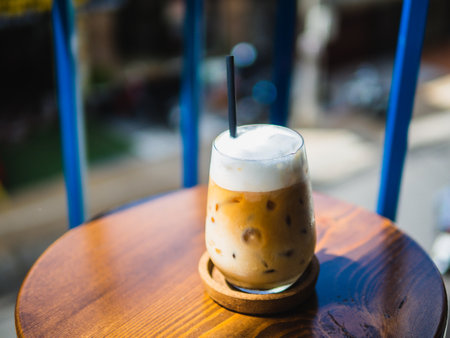Introduction: London’s Coffee Culture and the Rise of Cold Brew
London’s relationship with coffee is as storied and vibrant as the city itself. From the historic coffee houses of the 17th century to today’s bustling neighbourhood cafés, the capital has long been a melting pot for coffee innovation. In recent years, amid the hum of flat whites and cortados, another trend has quietly percolated into prominence: cold brew. This chilled, slow-steeped elixir found a particularly receptive audience among Londoners, whose appetite for new experiences is matched only by their reverence for tradition. The city’s café culture—ever evolving, always eclectic—provided fertile ground for cold brew’s ascent. With each artisan barista and independent roastery eager to experiment, London became a laboratory where coffee trends are not just imported but reimagined through a distinctly local lens. As we trace the journey of cold brew from curiosity to staple, it becomes clear that London’s cafés were more than mere backdrops—they were active agents in shaping how this refreshing drink captured the hearts (and taste buds) of a restless city.
2. The Arrival of Cold Brew: From Curious Novelty to Café Staple
Cold brew’s journey into the heart of London’s café culture reads like the introduction of an eccentric friend at a traditional British tea party—at first met with raised eyebrows, but soon winning everyone over with undeniable charm. Tracing its arrival, we find that cold brew was initially viewed as a curious novelty, something that globetrotters and coffee aficionados might order in search of a new taste sensation. Yet, it didn’t take long for London’s more adventurous cafés—often tucked away in Shoreditch backstreets or scattered across Hackney’s independent scene—to spot the potential for this chilled, slow-brewed delight.
These early adopters faced the dual challenge of both introducing cold brew and tailoring it to suit British sensibilities. After all, the British palate is steeped in a history of hot drinks: from the comfort of builder’s tea to the ritual of morning espresso. So, how did they do it? Let’s break down their approach:
| Adoption Strategy | Details | London Café Examples |
|---|---|---|
| Education & Tasting Events | Cafés hosted tasting sessions to demystify cold brew, explaining its brewing process and flavour profile. | Kaffeine (Fitzrovia), Workshop Coffee (Clerkenwell) |
| Bespoke Blends | Roasters experimented with beans and roast profiles to create smoother, less acidic brews appealing to local tastes. | Ozone Coffee Roasters (Shoreditch), Climpson & Sons (Broadway Market) |
| Seasonal Menus | Cold brew was pitched as a refreshing alternative during warmer months, often paired with summer pastries. | Lantana Café (Shoreditch), Timberyard (Seven Dials) |
| Cultural Pairings | Some cafés encouraged pairing cold brew with classic British bakes—think Victoria sponge or Eccles cake—to bridge old and new traditions. | Pavilion Café (Victoria Park), Gail’s Bakery (multiple locations) |
This gentle but deliberate process helped cold brew shed its reputation as an American import and become part of London’s own evolving coffee narrative. Early pioneers didn’t just serve cold brew; they reimagined it for a city where café culture is as much about community and conversation as it is about caffeine. By threading innovation through familiar rituals, these cafés transformed cold brew from a passing trend into a beloved staple—proof that Londoners are always ready for a new chapter in their beverage story, provided there’s room for a bit of wit and warmth along the way.

3. Cafés as Tastemakers: Influencing Palates and Preferences
London’s independent cafés, with their knack for reinvention and a certain homegrown charm, have become the city’s unofficial tastemakers. In an urban landscape where history and modernity collide at every street corner, these coffee havens have redefined what it means to enjoy a cup of coffee. The gentle hum of conversation, the clatter of saucers, and the ever-present aroma of freshly ground beans set the stage for a more adventurous approach to drinking coffee—one that extends far beyond the usual flat white or builder’s brew. As cold brew began its subtle infiltration into London’s café menus, it wasn’t just another beverage; it was an invitation to experiment.
Independent baristas, often as passionate about flavour notes as any sommelier is about wine, started offering cold brew not just as a novelty but as an experience. Detailed explanations of single-origin beans, tasting flights served over ice, or creative infusions with botanicals became part of the ritual. These cafés encouraged customers to step out of their comfort zones, fostering curiosity and a willingness to try something new. Suddenly, ordering a cold brew felt like participating in an urban rite—an assertion of individuality within a collective trend.
This shift was about more than just taste; it was about reshaping expectations. Londoners, known for their discerning palates and appetite for authenticity, quickly warmed to the idea of sipping slow-steeped coffee in sun-dappled courtyards or tucked-away basement nooks. The city’s independent cafés didn’t simply serve cold brew; they curated moments and memories around it. Through clever storytelling, seasonal specials, and collaborations with local roasters, they elevated cold brew from a passing American import to a beloved staple on the capital’s coffee scene.
4. Aesthetic Appeal: Presentation and Social Media
Wander through the streets of Shoreditch or Soho, and youll soon notice that cold brew is more than just a drink—its an aesthetic statement. London cafés have become curators of a unique visual culture, leveraging the city’s love for stylish spaces and photogenic moments to boost cold brew’s urban cool factor. The presentation of cold brew—often served in minimalist glassware with crystalline clarity—has turned every pour into a small-scale art installation. These subtle yet deliberate choices resonate with Londoners’ affinity for understated elegance and design-led experiences.
The interiors themselves play a critical role in this transformation. Many independent coffee shops across the capital, from Hackney hideouts to Notting Hill nooks, feature pared-back décor: think exposed brickwork, reclaimed wood, potted greenery, and industrial lighting. This backdrop amplifies the visual appeal of cold brew, encouraging customers to linger, snap photos, and share their experience online. It’s an unspoken invitation to slow down and soak in the atmosphere—a gentle antidote to the city’s usual pace.
Of course, Instagram has been instrumental in propelling cold brew into mainstream consciousness. Café owners understand that a well-composed flat lay or a hand cradling a condensation-flecked glass can speak volumes on social media feeds. Hashtags like #LondonCoffee and #ColdBrewLondon help these images travel far beyond their neighbourhoods, inspiring others to seek out similar experiences. The interplay between physical space and digital sharing has created a feedback loop, making cold brew not just a beverage but a lifestyle emblem.
Key Elements of Cold Brew Aesthetic in London Cafés
| Aesthetic Element | Description | Impact on Popularity |
|---|---|---|
| Minimalist Glassware | Sleek tumblers or jars showcasing the clarity of cold brew | Enhances visual appeal; encourages photo sharing |
| Cool Interiors | Industrial chic or Scandi-inspired design elements | Creates a memorable environment; attracts trend-conscious clientele |
| Social Media Integration | Cafés encourage tagging & feature customer photos online | Builds community; spreads awareness rapidly across platforms |
The result? Cold brew becomes synonymous with London’s ever-evolving café scene—an emblem of both taste and style, where every sip is an invitation to participate in the city’s ongoing cultural conversation.
5. Seasonality and British Weather: Cold Brew Beyond Summer
If there’s one thing every Londoner knows intimately, it’s the city’s capricious weather—grey drizzle in July, a sunbeam streaking through November clouds, and that perennial, unpredictable chill lurking just behind the next corner. Yet, rather than letting the fickle forecast dictate their menus, London cafés have shown remarkable ingenuity in championing cold brew as more than just a fleeting summer affair. The city’s coffee artisans have recast cold brew from its origins as a heatwave indulgence to an all-season staple, perfectly at home amid misty mornings and damp afternoons alike.
From the independent shops tucked along Shoreditch High Street to established chains in bustling Soho, baristas have leaned into the British love of novelty and comfort. Cold brew offerings are dressed for winter with warming spices—think cinnamon or clove infusions—and served alongside orange-zest pastries or toasted crumpets. Some cafés even play with temperature, presenting “cold” brews over ice or gently chilled, but also experimenting with nitrogen-infused versions that evoke the creamy body of a stout, making them as satisfying in February as they are in August.
This reimagining is not just about taste but about experience. In a city where seasons often blur together beneath a steely sky, Londoners take pleasure wherever they can find it—a window seat, a book, and a glass of cold brew that feels both refreshing and quietly indulgent. Cafés have tapped into this urban rhythm, marketing cold brew as a mood: brisk for balmy days, comforting for those when the Thames fog creeps in.
By divorcing cold brew from purely seasonal associations and embedding it within the year-round coffee culture, London’s cafés have fostered an environment where curiosity trumps tradition. It’s this open-mindedness—perhaps uniquely metropolitan—that has helped transform cold brew from a passing trend to a permanent fixture on the city’s menu boards.
6. Local Twists: British Innovations on Cold Brew
If cold brew first landed in London as an imported curiosity, it has since morphed into something uniquely British, thanks to the ingenuity and restless creativity of the city’s cafés. Londoners have never been content with simply adopting global trends; they reshape them to suit local tastes and values. This is where the city’s cold brew scene takes a left turn, infusing the chilled coffee ritual with regional character, homegrown ingredients, and collaborative spirit.
Regional Ingredients: From Allotments to Espresso Bars
London cafés are embracing local flavours by integrating quintessentially British ingredients into their cold brew recipes. Think of a cold brew subtly sweetened with Kentish strawberries at the height of summer or infused with fragrant Yorkshire rhubarb. Some daring baristas have even experimented with infusions of elderflower cordial or a hint of Cornish sea salt, creating drinks that feel both cosmopolitan and unmistakably rooted in Britain’s own soil.
Unique Brewing Techniques: A Nod to Tradition
While classic Japanese-style slow drip towers are still found behind many counters, some London cafés have developed hybrid brewing methods that reflect the city’s knack for innovation. There are places that age cold brew in whisky barrels from Islay distilleries, lending peaty undertones to the final cup. Others experiment with nitro taps, giving their cold brew a creamy head reminiscent of a well-poured pint—an affectionate wink to pub culture but served before noon.
Collaboration Across the Capital
The creative energy doesn’t stop at café doors. Many establishments partner with local chocolatiers, craft breweries, or even distilleries to create limited-edition cold brews. Imagine sipping a collaboration between an East London roastery and a Bermondsey gin-maker—a refreshing cold brew tonic spiked with botanicals, perfect for a rare English heatwave. These partnerships not only champion London’s artisanal community but also offer customers a taste experience that is entirely London: unexpected yet utterly harmonious.
In this way, London cafés continue to redefine what cold brew can be, ensuring that each glass tells a story of place, partnership, and playful innovation—a true testament to how global trends thrive when filtered through the prism of local culture.
7. Conclusion: Cold Brew’s Place in the Fabric of London Life
In tracing the rise of cold brew across London, it becomes clear that this once-humble beverage has evolved into more than just a passing trend—it’s etched itself into the capital’s café culture and, indeed, the city’s identity. The cold brew phenomenon is a testament to how Londoners continually embrace the new while celebrating the old, mixing global influences with local charm. Wandering through Hackney or Soho, you’ll spot cold brew on menus scrawled in playful chalk, often nestled between flat whites and builders’ tea—a nod to both tradition and innovation. The drink’s chilled smoothness fits seamlessly with the city’s fast-paced yet reflective rhythm; it’s a cup for creatives sketching in window seats, freelancers tapping away at laptops, or friends gathering after a gallery jaunt. In many ways, cold brew has become a symbol of London’s boundary-pushing café landscape: open-minded, experimental, and endlessly diverse. It represents not just refreshment but also connection—a shared ritual that brings together people from every walk of life. So as cold brew continues to pour through the veins of London’s coffee scene, it stands as proof that even the simplest pleasures can unite a city forever on the move.

